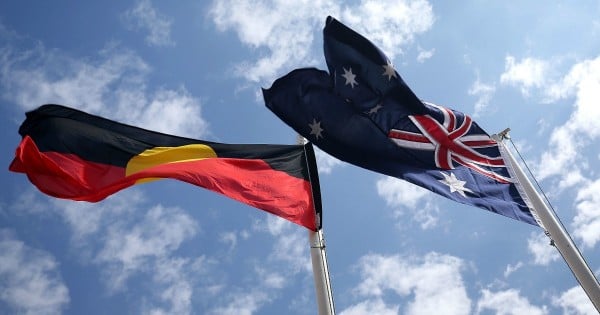
Earlier this week, Prime Minister Malcolm Turnbull was been moved to tears while telling journalist Stan Grant the story of an elderly Indigenous woman who recalled her mother singing to her in the dying Ngunnawal language as a child. He heard the story while preparing for his speech to Parliament at the start of February when he spoke the language of the traditional owners of the land around Parliament House. It was the first time an Indigenous language had been spoken in the Federal Parliament.
Cara Kirkwood writes for Mamamia about what the PM’s tears mean for the future…
“The thing that’s so sad is to imagine that mother singing that story to her [child] at a time when you’re losing culture,” said Malcolm Turnbull. “The last thing that baby was, was safe. That’s why it made me sad.”
The words above are the last of a snippet from an interview with our Prime Minister, Malcolm Turnbull and Stan Grant, possibly our soon to be announced Indigenous candidate (but for now our NITV Interviewer and Indigenous Affairs Editor of The Guardian),
Watch part of Turnbull’s interview here. Post continues below.
“..and the last thing that baby was, was safe.”
Let’s imagine the baby to be policy relating to Indigenous peoples in our shared nation. And for Aboriginal & Torres Strait Islander people, who have been ruled by paternalism since invasion (and Federation subsequent to that), this is no stretch of the imagination. Failed policy, after failed policy has been encountered and goal posts have been continually shifted. Disturbingly, short term solutions have been deceptively celebrated, or so it feels. The Rudd apology of 2008 felt like bursting midday sunflowers… for the first year.

Top Comments
It is without doubt that some bad things happened to indigenous children in the past, we can't change that, but we can change some of the bad things that are happening to indigenous children RIGHT NOW. "Between 1 July 2012 and 30 June 2014, for every 1,000 Aboriginal and Torres Strait Islander children in Australia, 38.3 were subject to a substantiation because they had been or were at risk of being abused, neglected or otherwise harmed. This means that Aboriginal and Torres Strait Islander children were 7 times more likely than non-Indigenous children to be the subject of substantiated reports of harm/risk of harm". But its likely even worse than that.... "there are several issues that contribute to the under-reporting of child abuse and neglect specifically in Aboriginal and Torres Strait Islander communities. These include:
fear, mistrust and loss of confidence in the police, justice system, government agencies and the media (Aboriginal Child Sexual Assault Taskforce, 2006; Anderson & Wild, 2007; Gordon, Hallahan, & Henry, 2002; Lievore, 2003);
fear of racism (Closing the Gap Clearinghouse, 2013);
fear that the child may be removed from the community (Anderson & Wild, 2007);
community silence and denial (Gordon et al., 2002);
social and cultural pressure from other members of the family or community not to report abuse or violence, and the belief that reporting is a betrayal of the culture and community (Aboriginal Child Sexual Assault Taskforce, 2006);
a belief in the need to protect the perpetrator because of the high number of Indigenous deaths in custody (Stanley, Tomison, & Pocock, 2003);
fear of repercussions or retaliation from the perpetrator or their family (Stanley et al., 2003);
personal and cultural factors of shame, guilt and fear (Aboriginal Child Sexual Assault Taskforce, 2006; Anderson & Wild, 2007);
lack of understanding about what child abuse and neglect is generally, and lack of understanding about what constitutes child sexual abuse specifically (Aboriginal Child Sexual Assault Taskforce, 2006; Anderson & Wild, 2007);
language and communication barriers, lack of knowledge about legal rights and the services available, and lack of services for Aboriginal victims (Anderson & Wild, 2007); and
geographical isolation (i.e., nobody to report to, no means of reporting and minimal contact with child welfare professionals) (Gordon et al., 2002; New South Wales Ombudsman, 2012; Stanley et al., 2003)."
Could the sexual abuse rate also contribute to the youth suicide rate?
Surely there are no mitigating factors for this child abuse?, if there were then all child abusers from any background or culture could also have mitigating factors to lessen their culpability right?
There's never been a better time to be an Australian with Pat Dodson being elevated to the Labor Party on a Senate ticket to replace the dinosaur Bullock.
Fantastic News.
All Magnifico Mal has to do is elevate Noel and we might get some results for our First Peoples, finally.